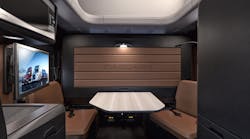In 1909, Henry Ford, the father of American motorized travel, famously said, “any customer can have a car painted any color that he wants as long as it’s black.”
In contrast, buyers of International’s current LT Series can choose from roughly 1,000 advertised options to customize their trucks’ interiors and nearly as many unadvertised ones, explained Jim Nachtman, marketing director for the company’s heavy-duty product segment.
Spec’ing interiors has come a very long way fast. Truck drivers who began their careers in the early 1980s wince at the memories of seats bolted to the floor and CB radio as the only alternative to AM/FM reception, which sometimes offered little choice and frequent static.
Today’s seats can be heated or cooled and adjusted in several ways while Sirius XM Radio provides constant entertainment and information. Some sleepers come with a table and chairs, and all kind of devices can be run on a truck’s various power units.
“When I started driving, I was in an old cabover,” recalled Ploger Transportation’s Joel Morrow, who has been behind the wheel of a truck for three decades. “I didn’t even have power steering. I had air wipers. Your hand was constantly on the radio tuning it from station to station to station as you were driving.
“Talk about distracted driving! CB radio was about the only form of communication you had,” he continued. “If you wanted to make a phone call, you had to stop and find a truck stop and then wait in line at the phone booth. You look back and wonder how did we ever drive any distance at all?”
In those days, there was always another driver if a job became available. The ongoing driver shortage has changed that, giving drivers more leverage and making spec’ing interiors more important even as the proportion of daycabs to sleepers is growing because more drivers want to be home at night rather than dealing with the rigors of long-haul transportation.
“People have probably been catering a little bit more toward the drivers,” said Stu Russoli, highway product manager at Mack Trucks. “There’s a lot more. ‘Give the guy a better seat. Give him satellite radio.’ “
Russoli advises fleets and drivers to get the most comfortable seats possible and adjust them to how the latter likes them because they’re in them all day long.
“For long-haul driving, you want to go with an ultra-leather that’s more comfortable, but if you’re in and out of the cab more often, maybe you want to go to a cloth seat or a [denim-like] heavy-duty seat,” Russoli said. “We have extensions that can be retracted or expanded so your legs can fit correctly. You can move the steering wheel to see all the gauges.
“Comfort and convenience are what matter in the sleeper: TV, microwave, refrigerator, power ports, being able to control your stereo and HVAC from the rear. And being able to store things is huge. If you’re gone for a week, you don’t want to be washing clothes all the time.”
Navistar, Mack, and other OEMs are also spending a lot more time asking drivers what they want, which helps explain the seemingly endless variety of choices that Nachtman cited.
“Before we launched the Anthem [in September 2017], we talked to hundreds of drivers,” Russoli said. “We had people in from focus groups. We had people get into prototypes. We did surveys at truck stops. We actually got into other OEMs’ trucks to see how the drivers lived in there.”
Nachtman said that his company has engineered mirrors and entry stairs for driver ease, adding that the vast majority of trucks that it sells have some creature comfort upgrades over the base offering.
“In the past, we used to bundle a lot of features together in packages,” Nachtman said. “Our à la carte pricing strategy allows fleets to order just the content they want.”
Fleets make economic decisions, but what if drivers had full freedom to spec their interiors?
“I’m 5’-2” so getting a seat that conforms to me is very important,” said North Carolinian Ingrid Brown, a truck driver since 1979. “I like a mid-back seat because it hits me at the top of my shoulders. The structure and the cushion of a seat are huge. I have leather armrests on both sides that are adjustable. I do run heated seats, not because it’s cold outside, but because I can turn that heat on for my back.
“I spent maybe $8,000 spec’ing the interior of my truck—including a 3,500-watt power inverter, a 26-inch mounted television, and a full cabinet package with a built-in business center—but it’s absolutely worth it because I live in my truck. I’m there more than I am in my own bed.”
Indeed, long-haul drivers like Brown and Morrow are away usually 250-300 nights a year.
“What might be suitable and great for a weekend camping trip or even a week-long camping trip isn’t suitable for us,” said Henry Albert, an owner-operator on the road since 1983, who has added solar power to complement his battery-operated HVAC. “In the past it was, ‘build the whole truck and we’ll figure out where we’ll fit the driver.’ [In contrast], my 2018 [Freightliner] Cascadia is by far the most spec’d interior I’ve had. I never thought I would use the table as much as I do, but I fold the bed up every day and it takes less than 30 seconds to switch it to a dinette.
“The bed folds out of the wall with an upgraded mattress,” he continued. “In some drivers’ lounges of the past, they wanted you to sleep on four cushions. I [once] told an engineer, ‘You sleep on four cushions for six months at home and get back to me.’ “
The 6’-5” Albert was long frustrated by having to look through the uppermost part of the windshield, the area that the wipers couldn’t reach.
“The Cascadias are the first trucks that I haven’t had to have the seat shoved all the way back and be wishing for more [room],” he said. “You’d end up cocking your neck a little bit and get a sore neck. I’d rather ride in this truck than in any car on a long trip out on the highway, that’s for sure.”
Albert advised his fellow drivers to buy the premium installation package on their trucks. “It’s worth its weight in gold. It quiets the truck down so much, and it makes your HVAC system more efficient,” he said. “That gets overlooked by many. [With] what they’ve done with ergonomics, ride quality and quietness of the truck, I can have a reefer back in next to me and it’s just a low drone.”
Ploger Transportation makes sure all of its trucks have a refrigerator, a 5,000-watt inverter, Sirius XM, and premium mattresses.
“There’s nothing worse than sleeping on a standard mattress where you can feel every spring,” Morrow said. “If you don’t sleep at night, you’re not well rested. A premium mattress is a little pricey, but it’s worth every penny.
“SiriusXM makes life more convenient and more comfortable. If a guy can plug in his coffee maker and electric shaver and doesn’t have to use adapters [and can have] a little freezer and not worry about ice and coolers tipping over,” he continued, “it takes a little bit of stress out of his daily life. The more you can help relieve any type of stress, [the more] it helps driver retention.”
Nussbaum Transportation driver Clark Reed said the best change from his early years behind the wheel is having power, heat and air conditioning without having to idle the truck.
“A lot of companies want to go cheap to save a few bucks, but seats make a big difference to driver comfort and fatigue,” he said.
Barb Duncan, who returned to driving in 2016 after a 13-year break, agreed. “If you have a fridge and an inverter, you’ll have better retention,” she said. “It shows that the company cares about the driver.”
Bernedette Wilson, Duncan’s fellow Canadian, put in a plug for a sink, a rare commodity in a truck because of the need for plumbing.
“Being clean is way better,” said Wilson, who like Duncan would love to have a toilet on board so being turned away from shippers’ restrooms wouldn’t force her to bring along paper cups and a Luggable Loo as portable emergency facilities.



